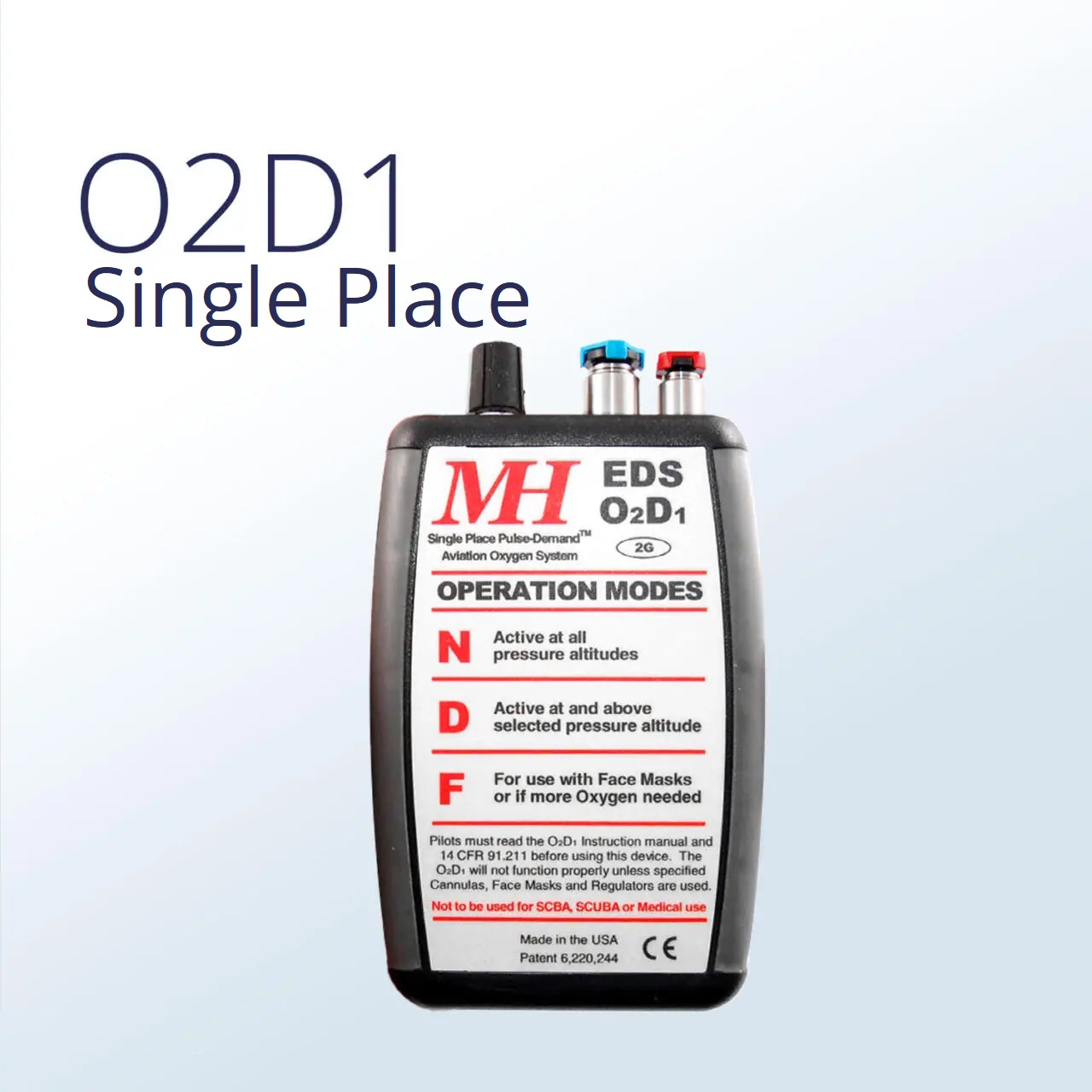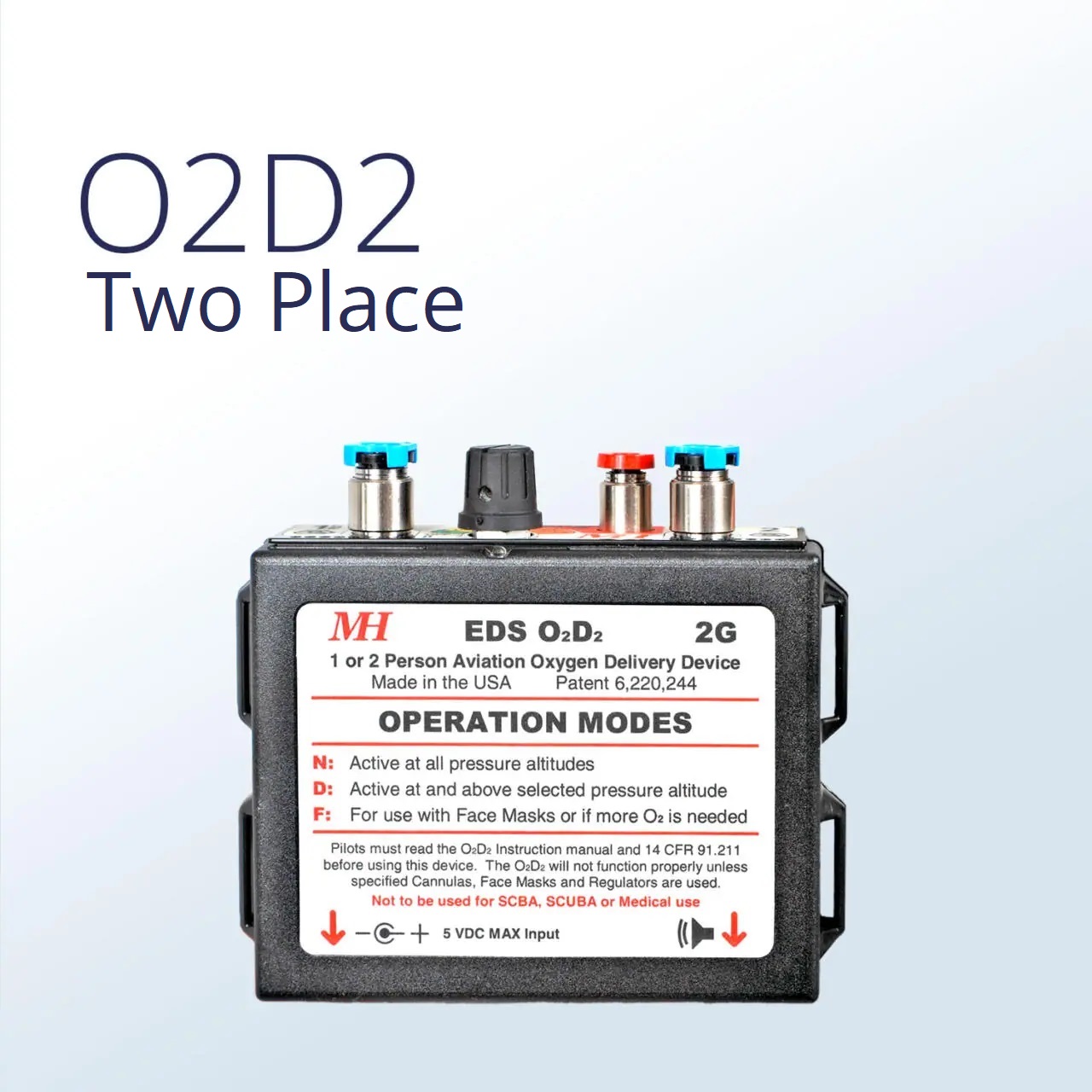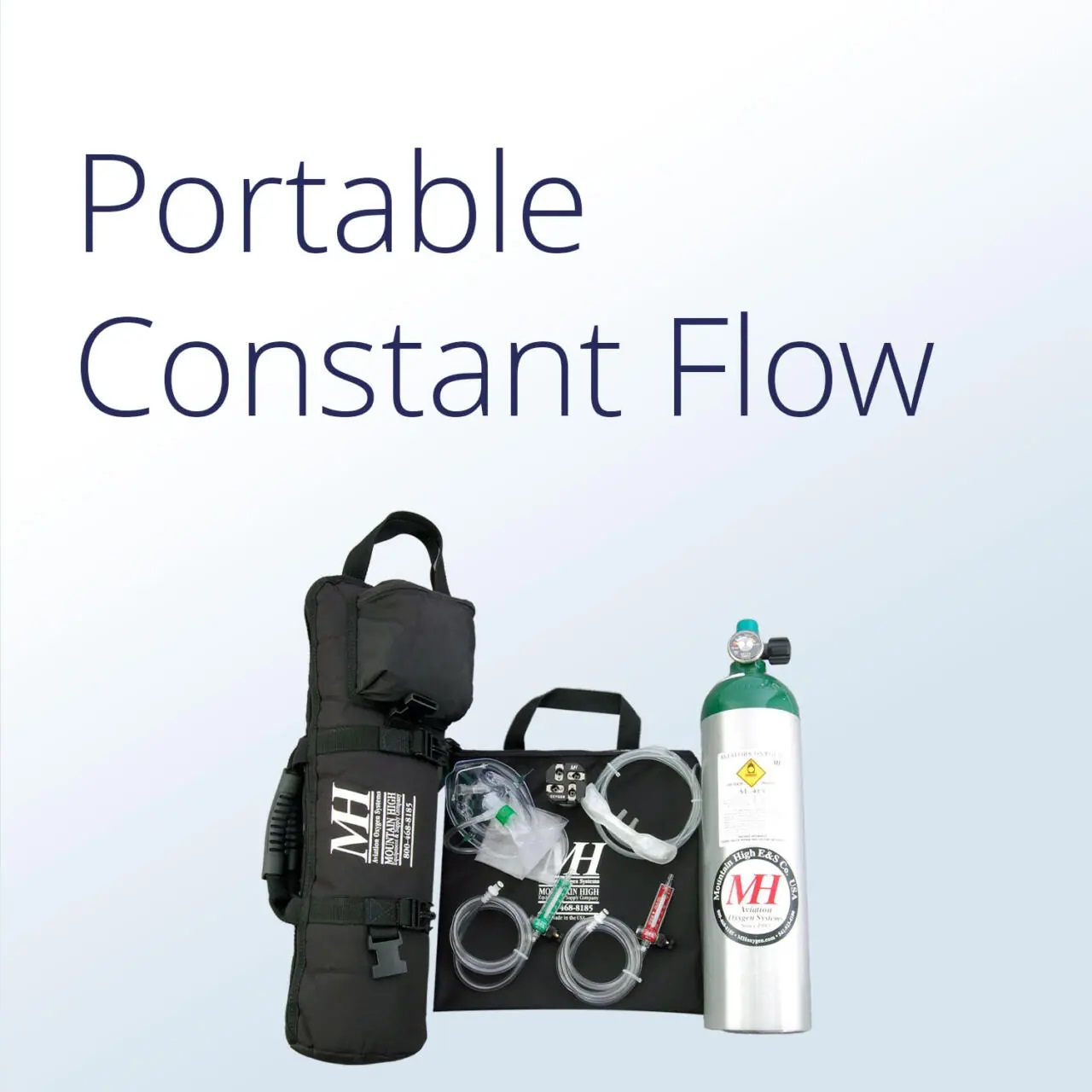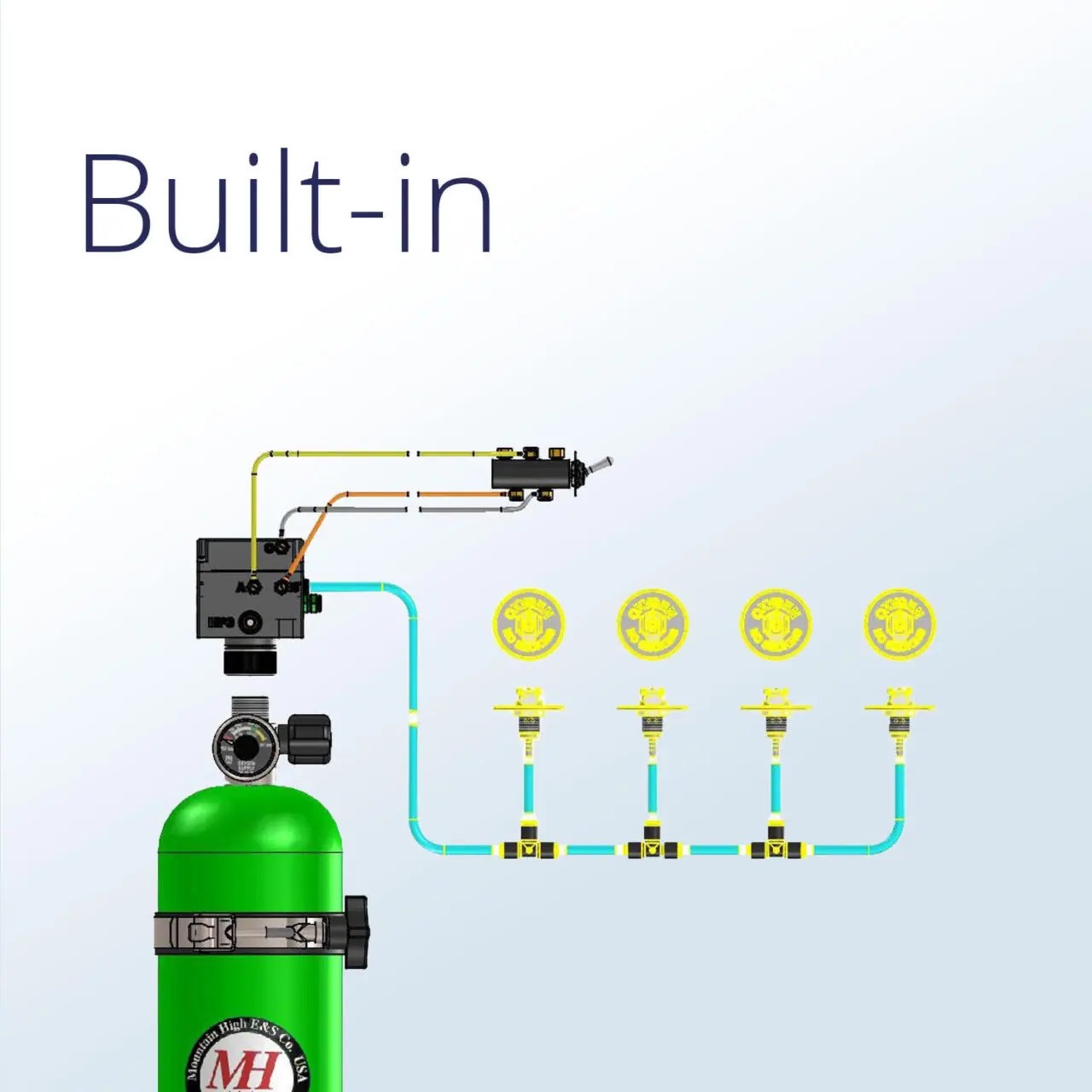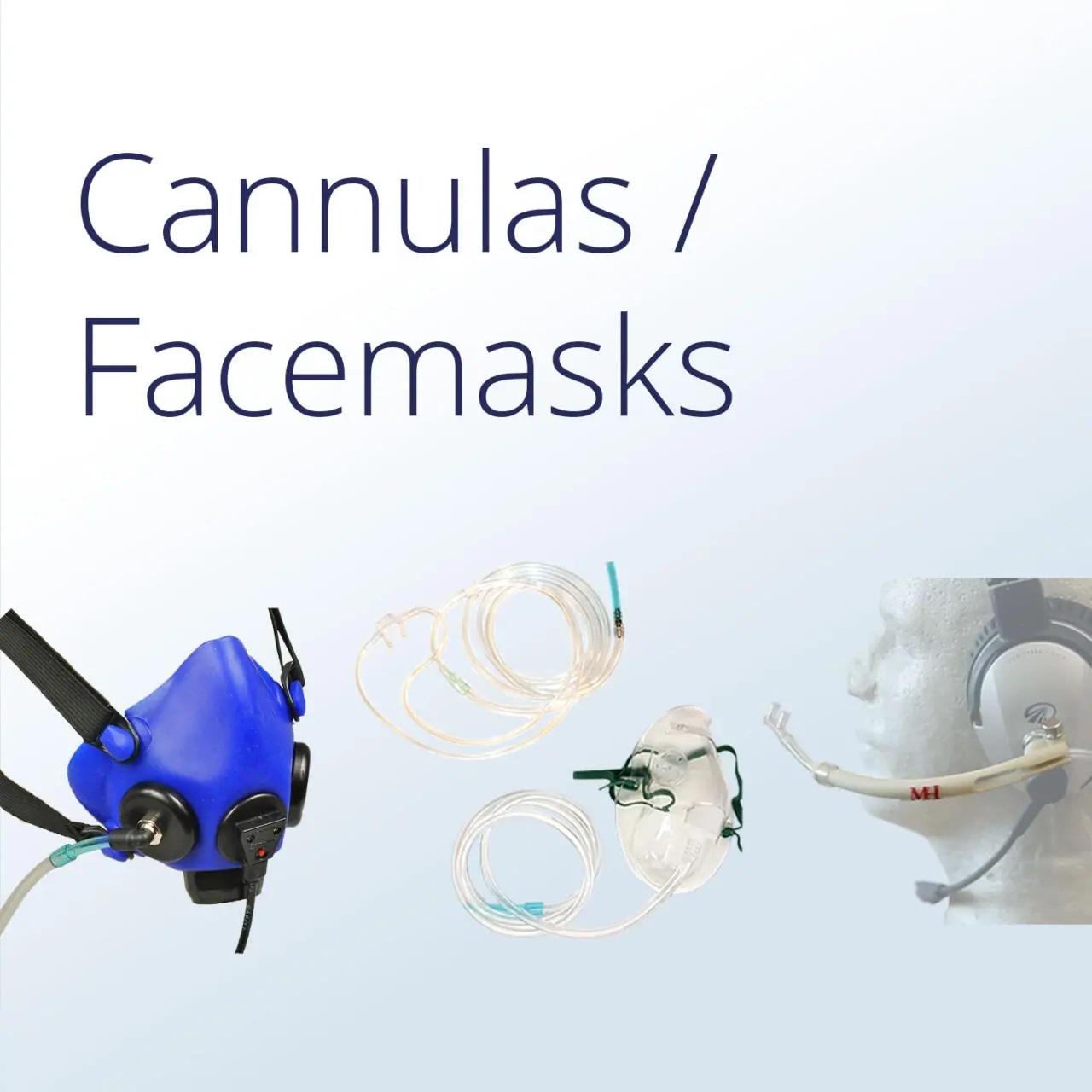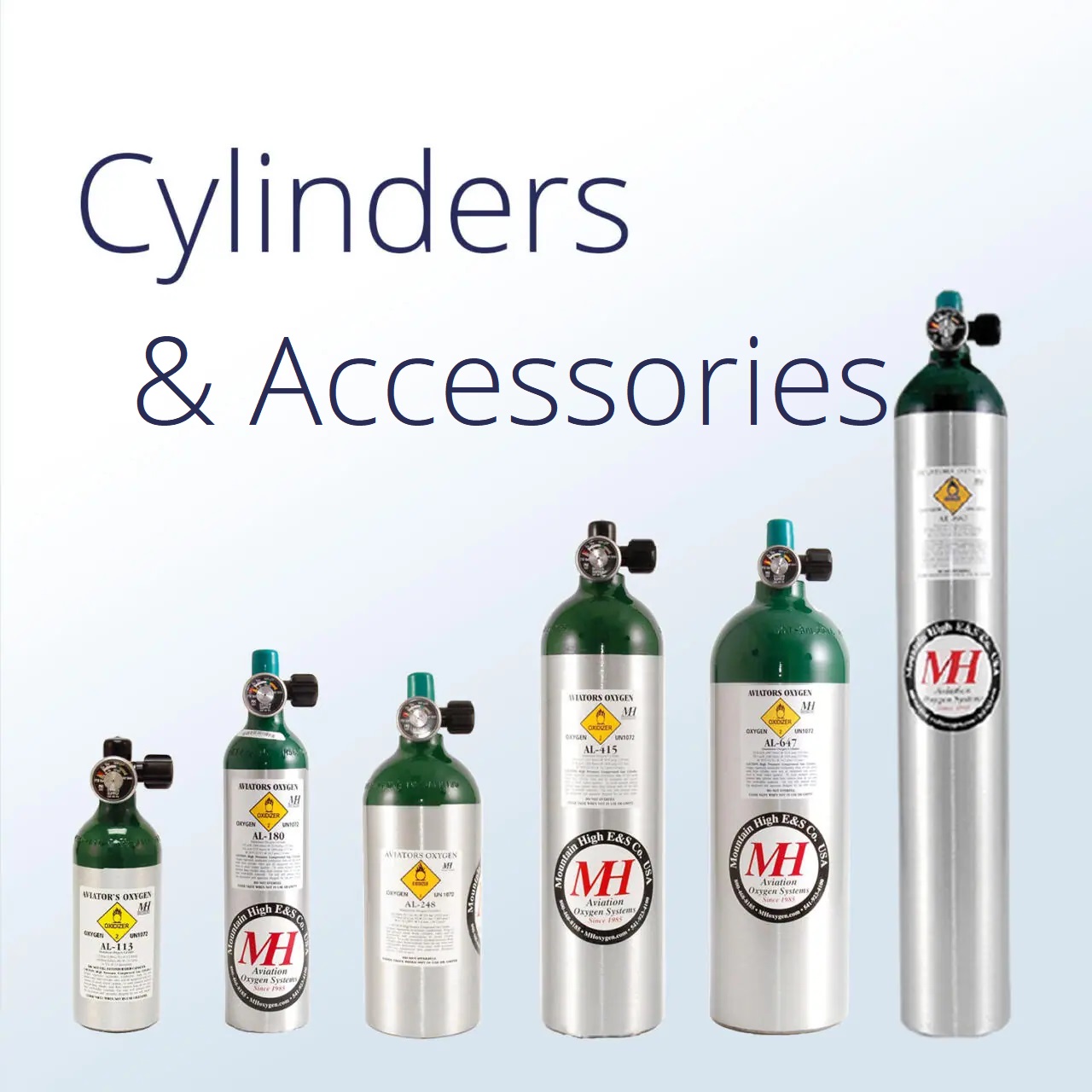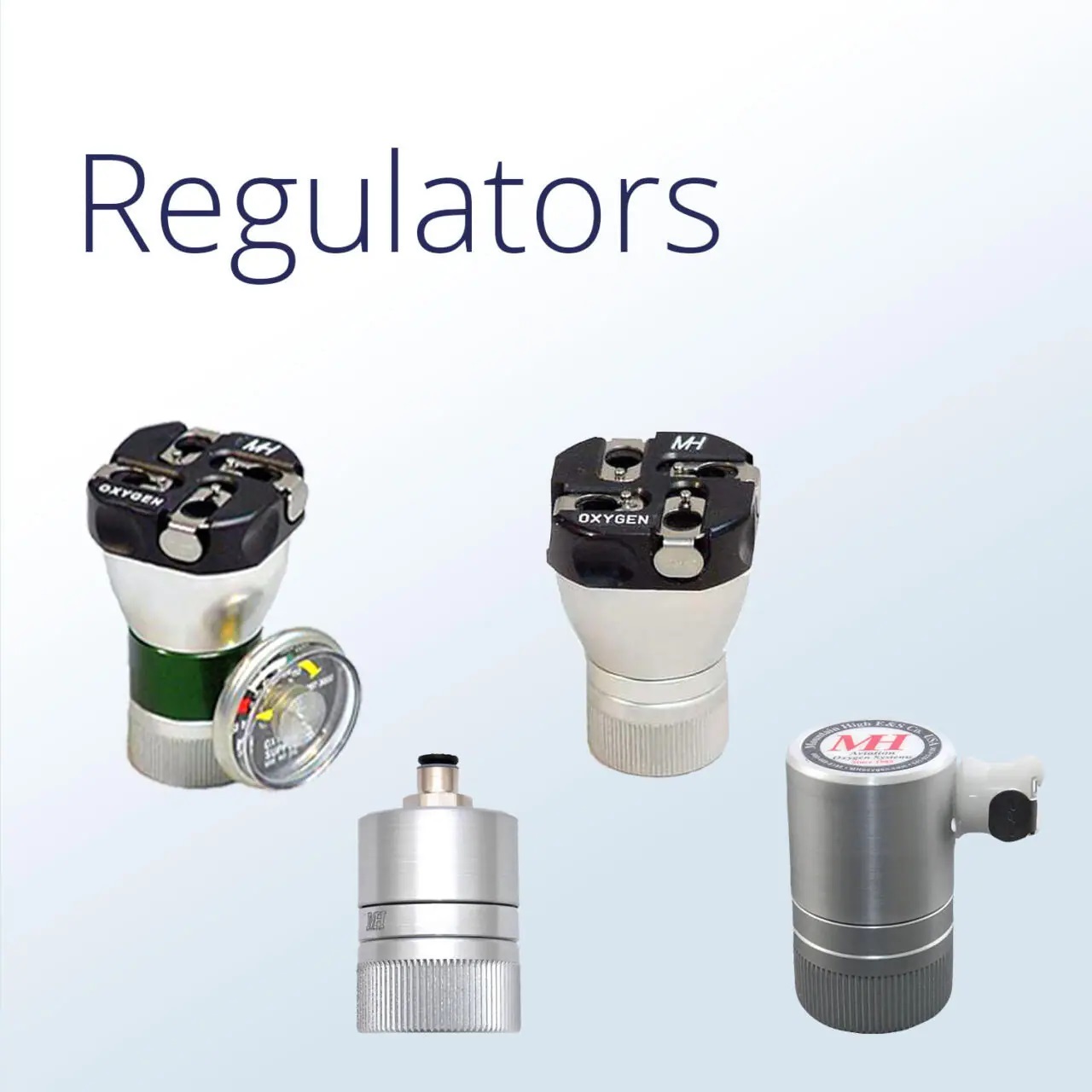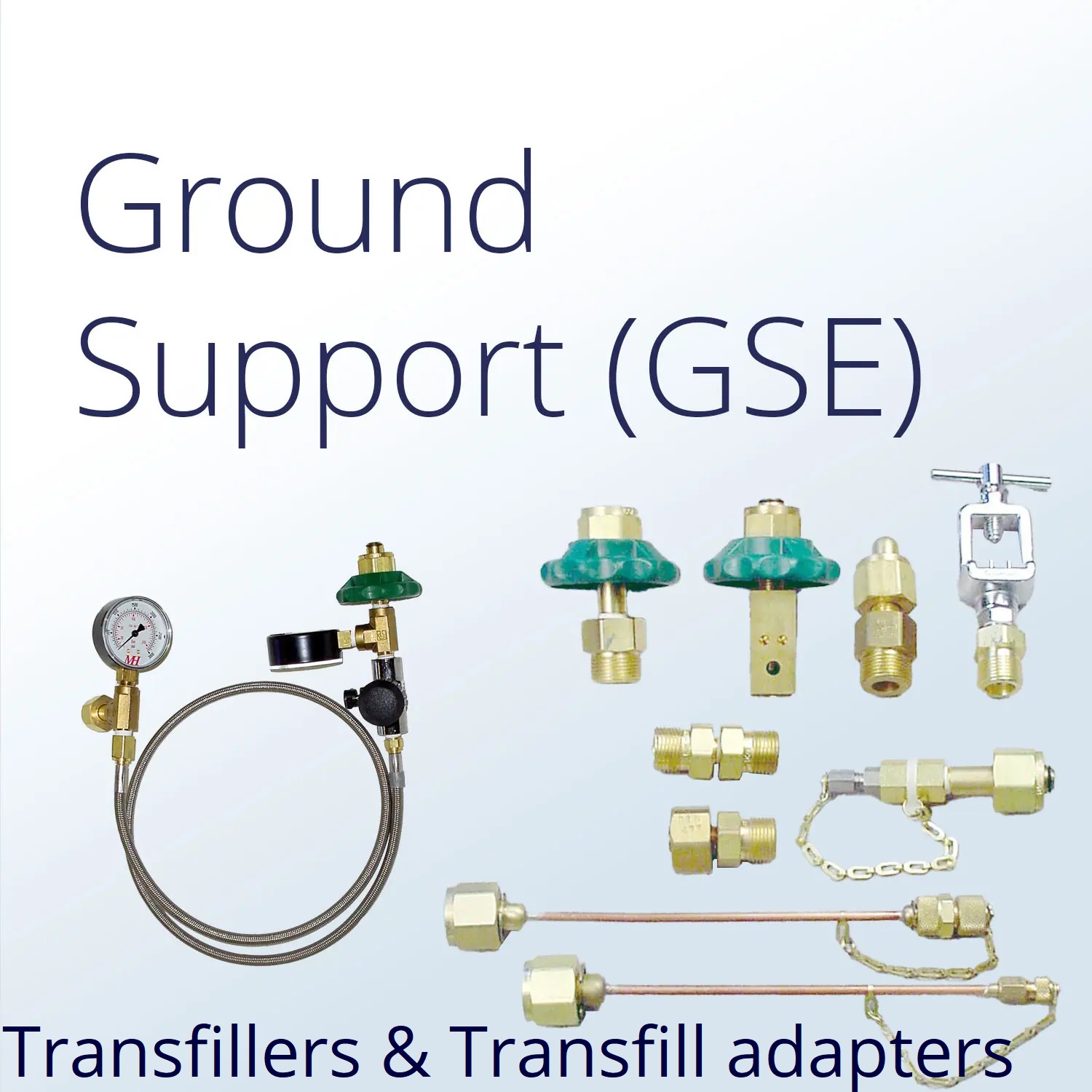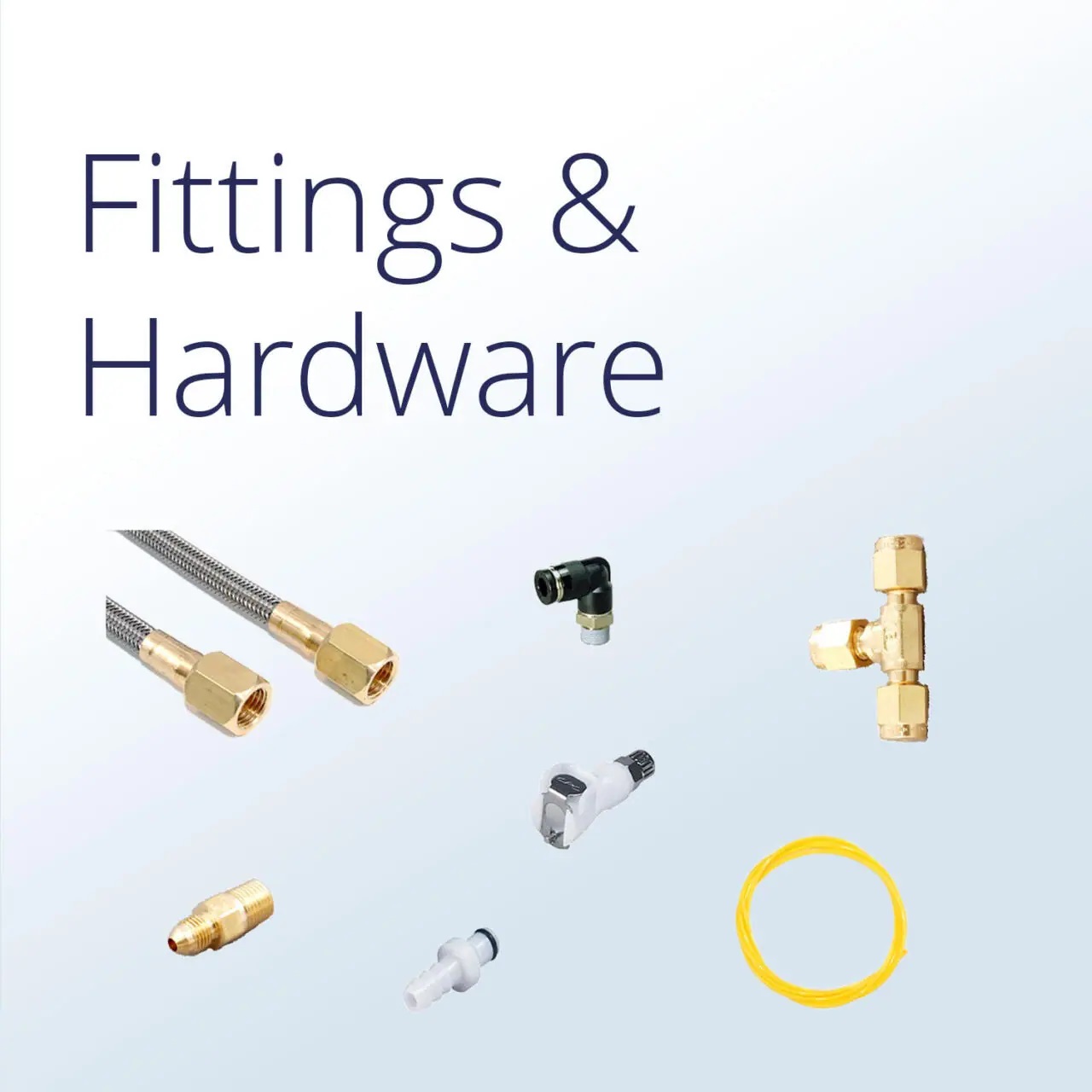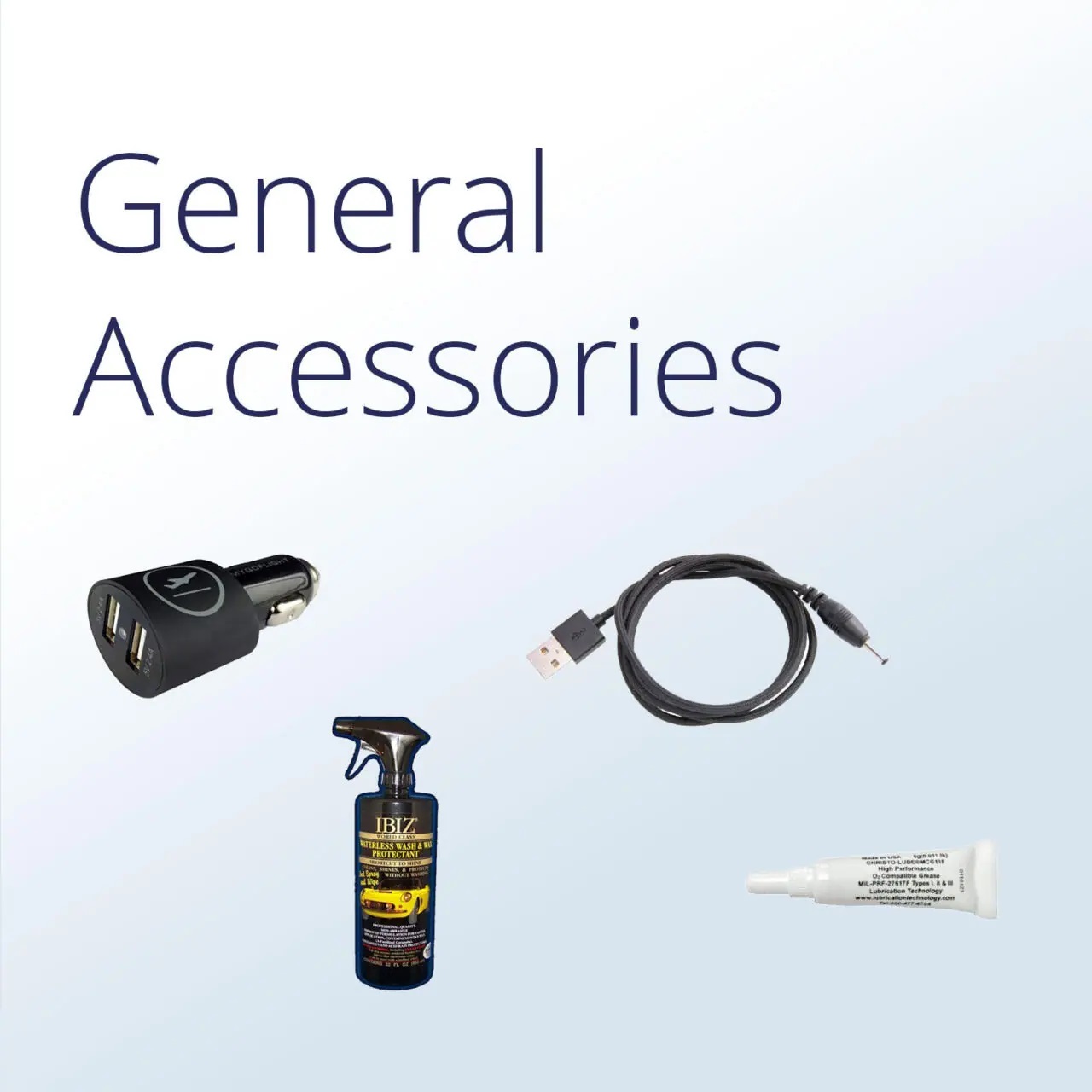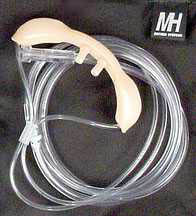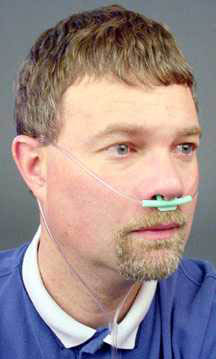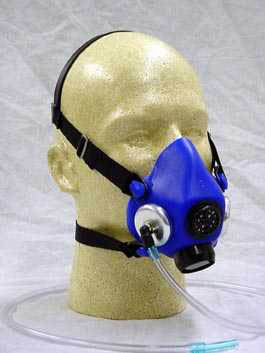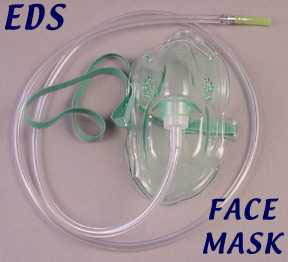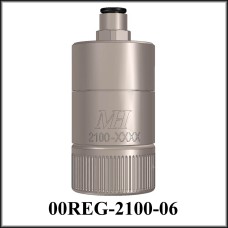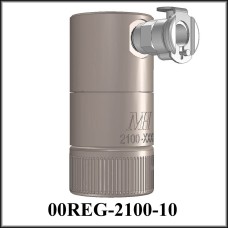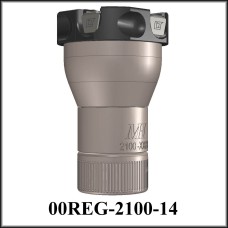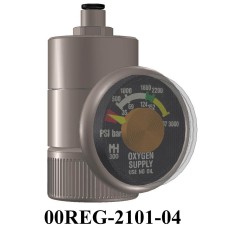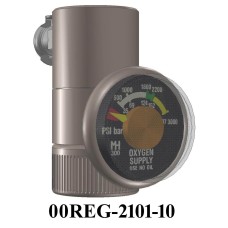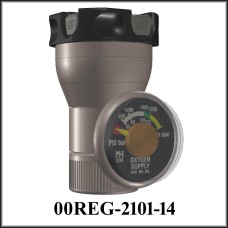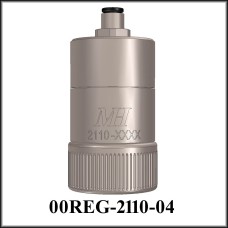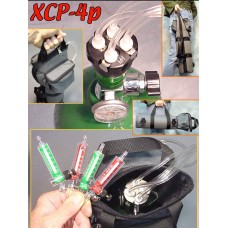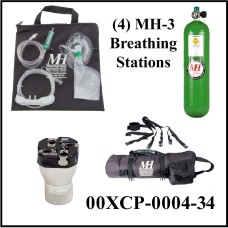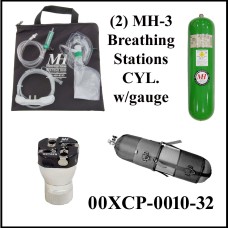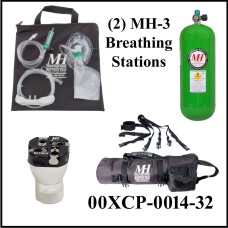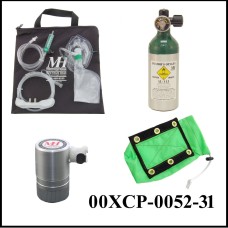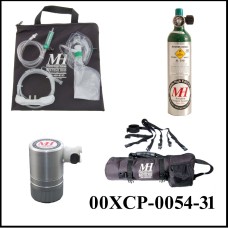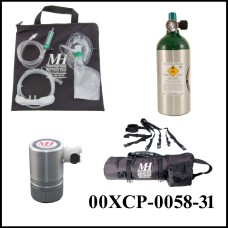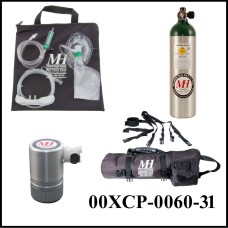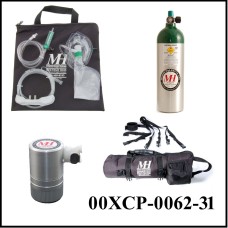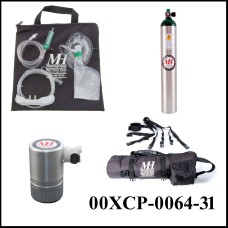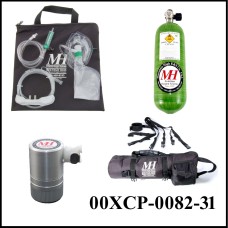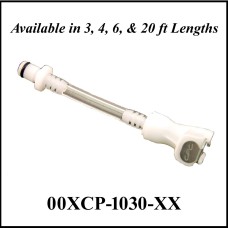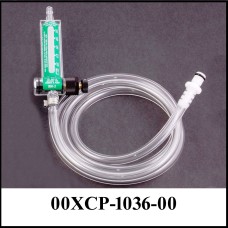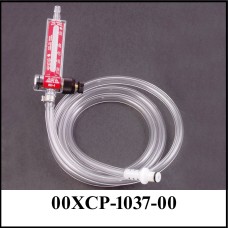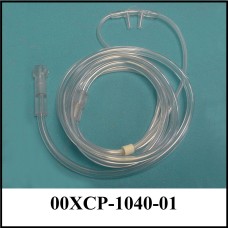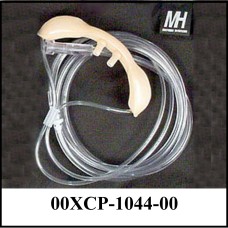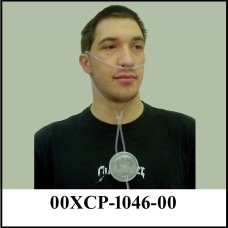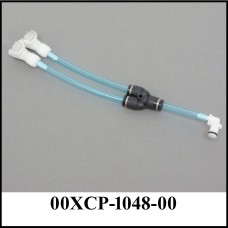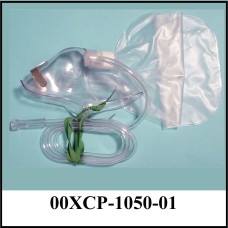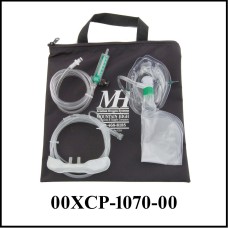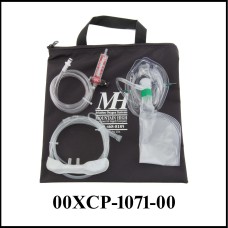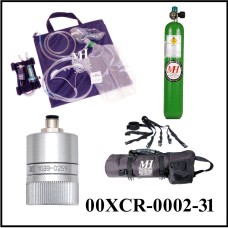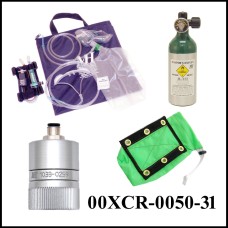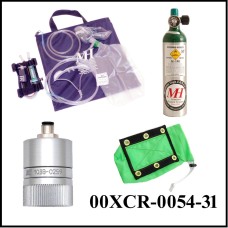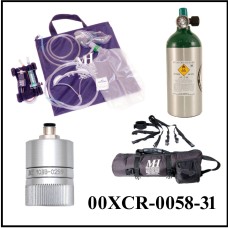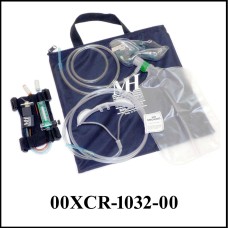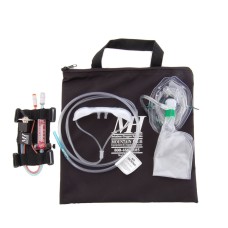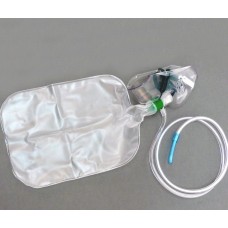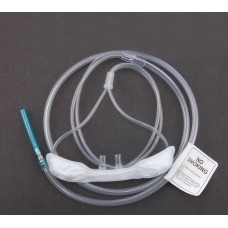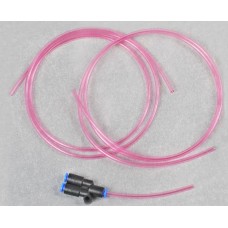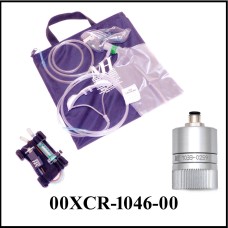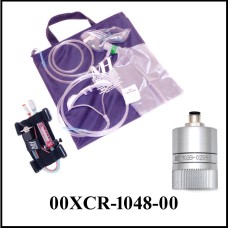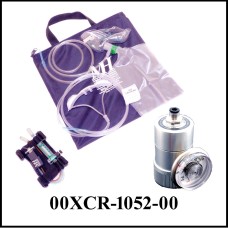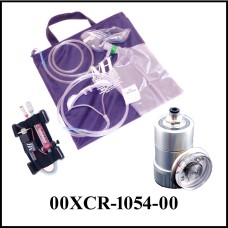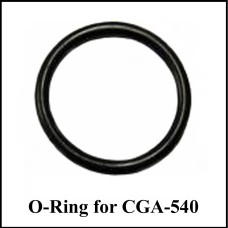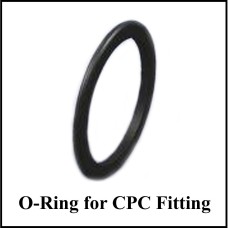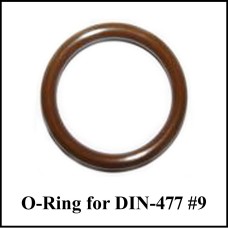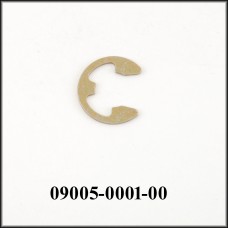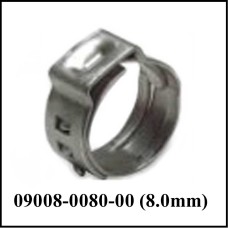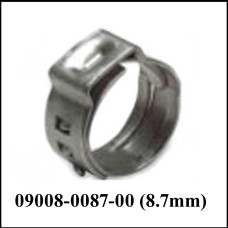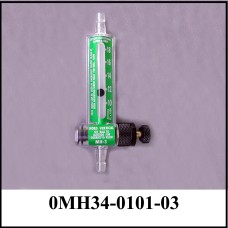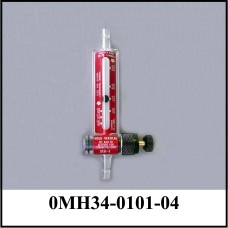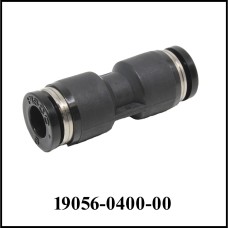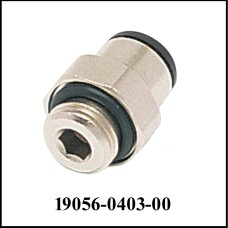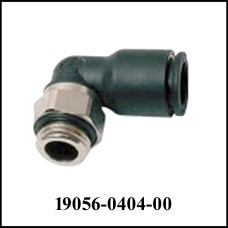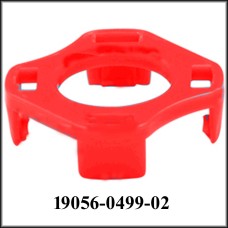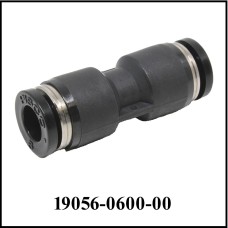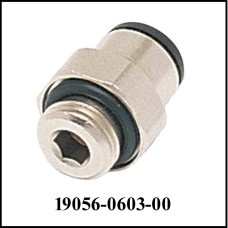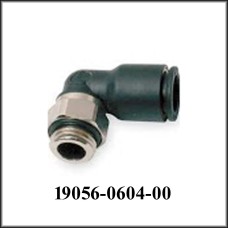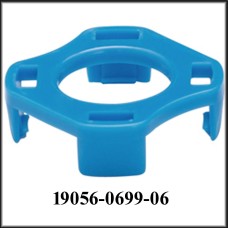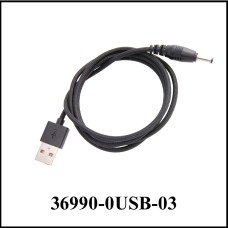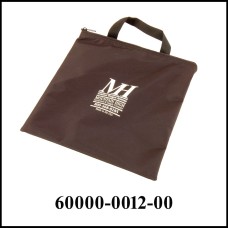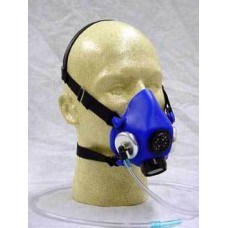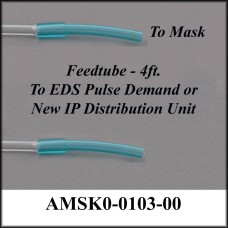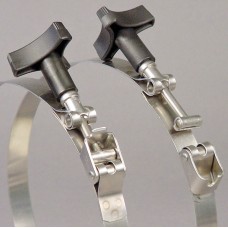Mountain High

Mountain High Equipment & Supply Company
Mountain High Home | EDS O2D1 | EDS O2D2 | Constant Flow | Cannulas & Face Masks | Cylinders | Regulators | Transfillers
Overview
Mountain High Equipment & Supply Co. is the maker of state-of-the-art aviation oxygen equipment.
Founded by recreational pilot and engineer Patrick L. Mclaughlin, Mountain High has been supplying aviation oxygen equipment and supplies since 1985. The company is known particularly for it's EDS product, an electronic 'Pulse-Demand' adaptive oxygen delivery device.
Mountain High has also been at the forefront of providing pilots of all types of aircraft with affordable and easy-to-use oxygen transfillers and adapters.
Please Buy From Me
I have tried to make the web site a useful resource. I have included many of the technical documents from the MH web site. Also, I found it difficult to figure out exactly what parts are included in the system kits when browsing the MH web site, so I have worked hard to make it very clear what parts are included with each system. I included photos of all the parts found in each system. I also created system duration tables for every complete system to help you find a complete system with the desired duration.
An aviation oxygen system is designed for and with components, such as the main reducing regulator (SAE AS1197, AS1248, ARP1109), developed for airborne aviation purposes. Unlike a medical-type oxygen system, an aviation system is generally much lighter, compact and calibrated to deliver oxygen per established FAA, FAR protocols based on extensive research in human flight physiology (SAE AIR822, AIR825B, AIR1389, ARP4259). Because of lower cost, ease of filling, servicing and certification testing, many portable aviation oxygen systems have been designed around a set of so-called standardized light-weight aluminum cylinders originally intended for the ambulatory medical market (AIR AS1065, AS1066, AS8010). An aviation oxygen system should meet minimum standards (SAE AS861, AS1046) for airborne applications. This includes the ability to be safely contained so that the system will not become a hazard during times of turbulence. The aviation oxygen system must be capable of being stored somewhat out of the crew's way and become available and operational at a moment's notice without much thought and distraction (SAE AIR1390). The human interface devices (cannulas & face masks) are very similar to medical types but generally modified or designed differently to facilitate items such as head-gear, microphones and other oxygen delivery devices and yield a more comfortable fit (SAE AS1224, AS8025).
A portable aviation oxygen system, in the basic sense, consists of four main components.
Supply of oxygen (cylinder) with on/off valve and gauge

Main reducing oxygen regulator (sometimes built-on the cylinder), The main reducing regulator takes the (wild) oxygen pressure from the cylinder and regulates it down to some manageable pressure for the delivery device. May types of regulators are found in aviation oxygen systems. Some include pressure gauges for monitoring the high pressure on the oxygen cylinder side.
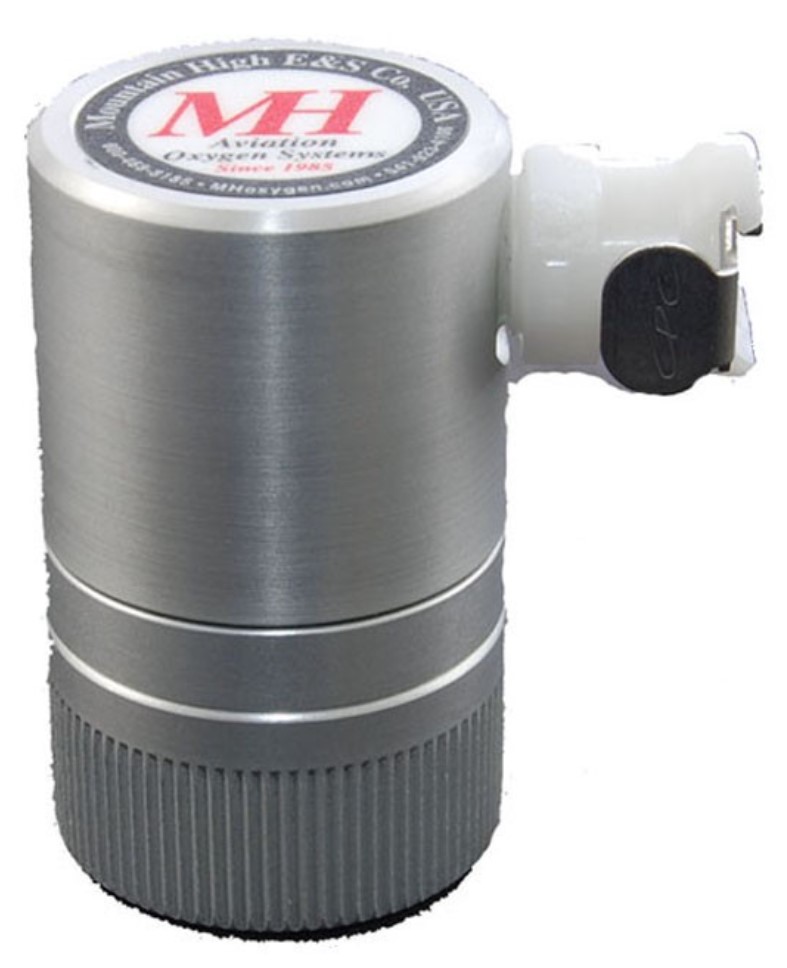
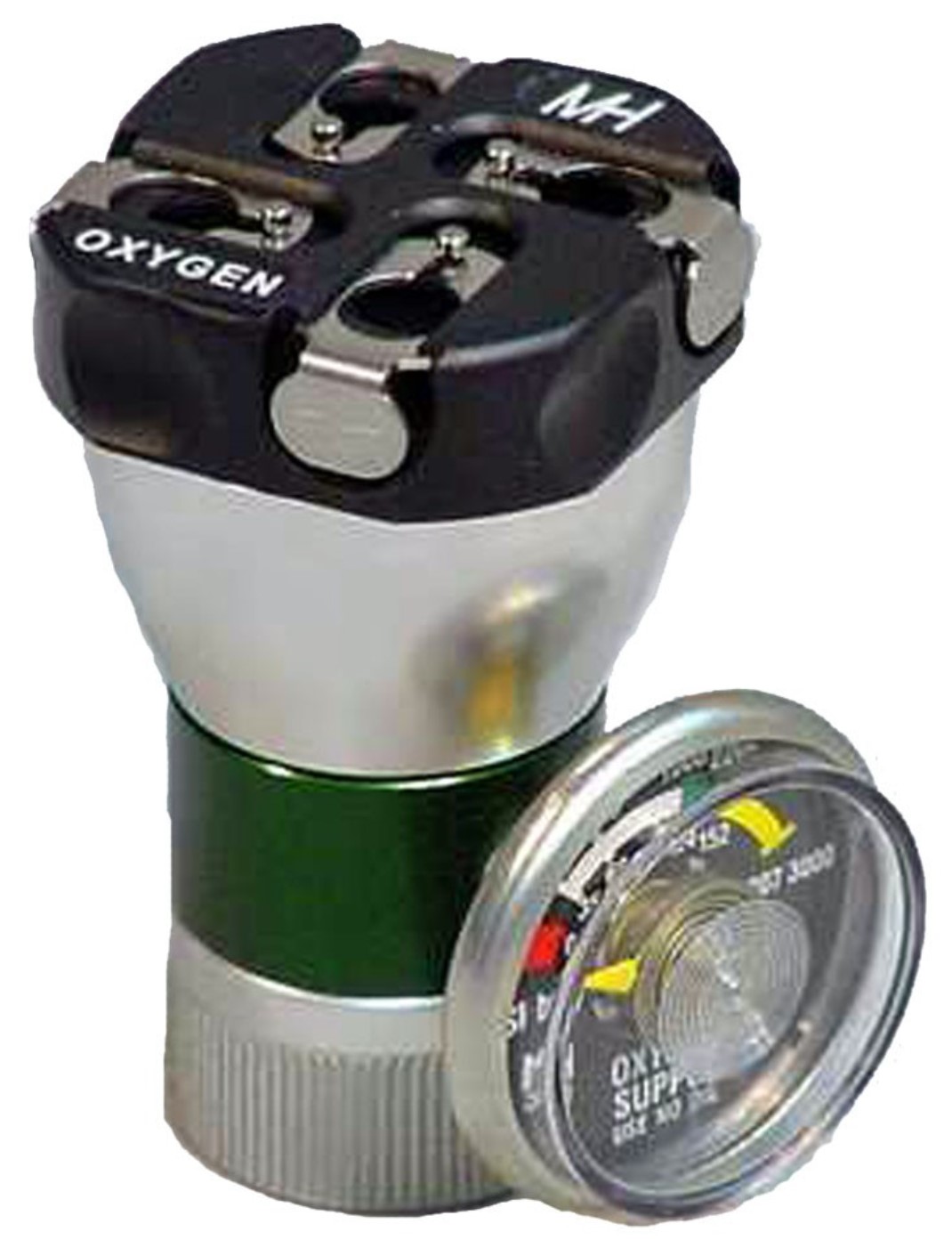
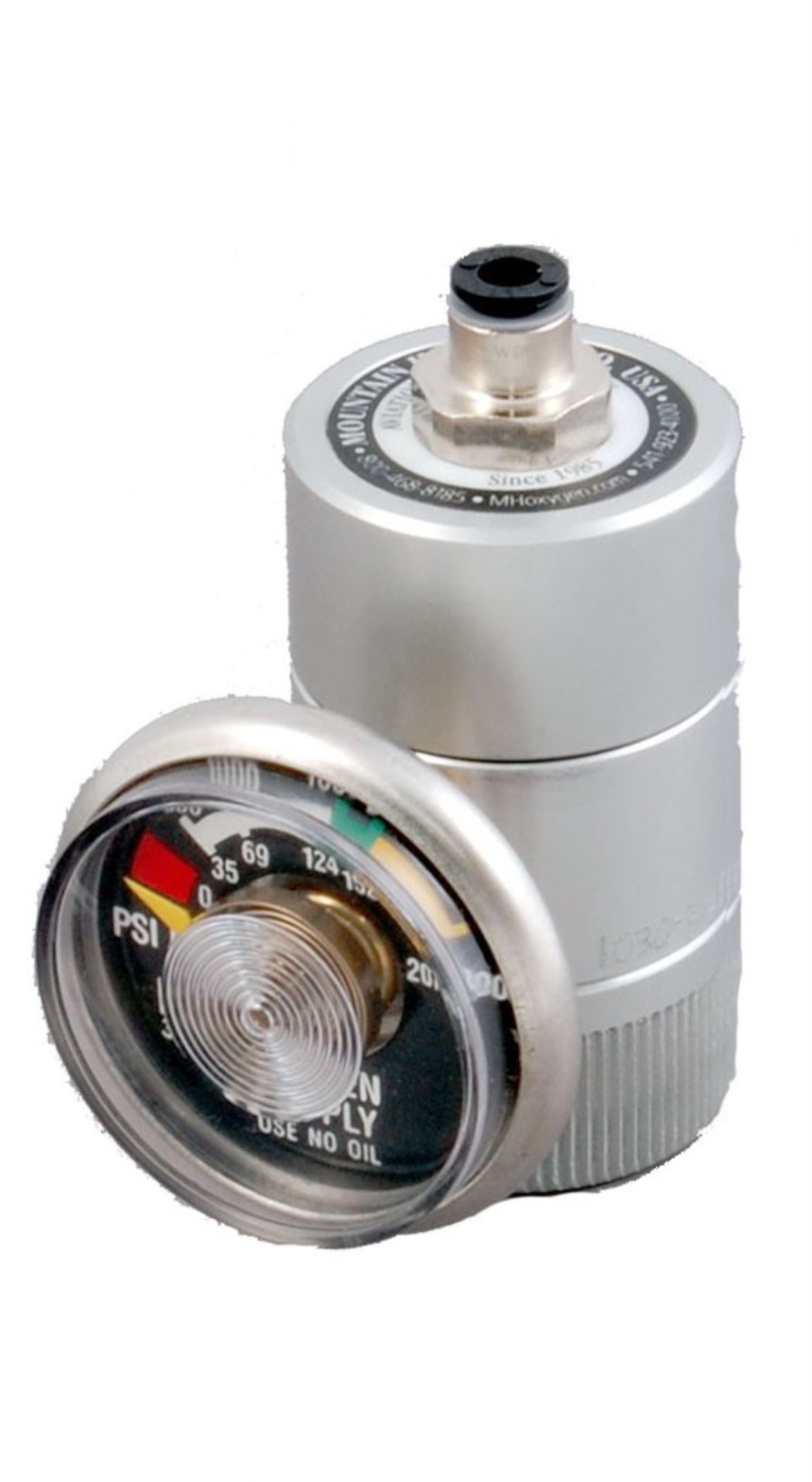
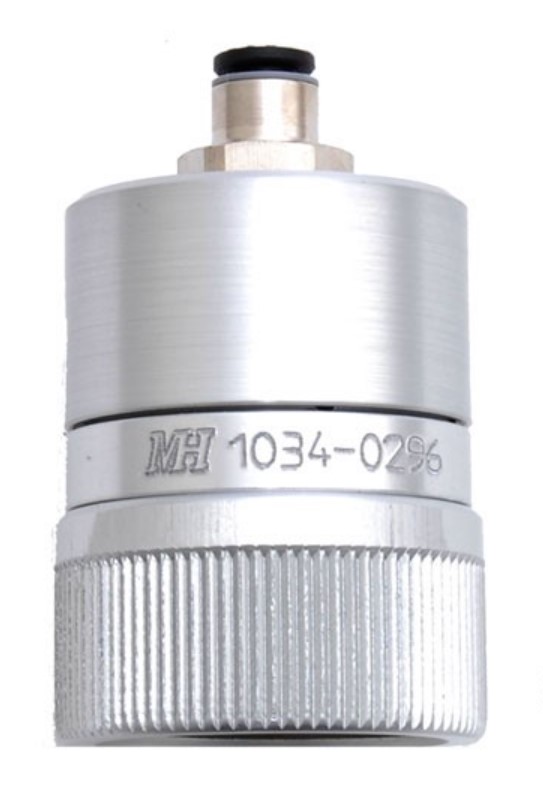
Oxygen delivery (flow control) device, automatic or manually controlled. The job of the oxygen delivery device (Pulse-Demand EDS or constant flow MH3 or MH4) is to provide oxygen at a pressure and flow needed for humans at varios altitudes. Often, the flow control is built into the main reducing regulator. Newer systems have separated this for easier use and control.
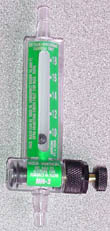
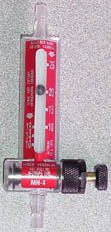
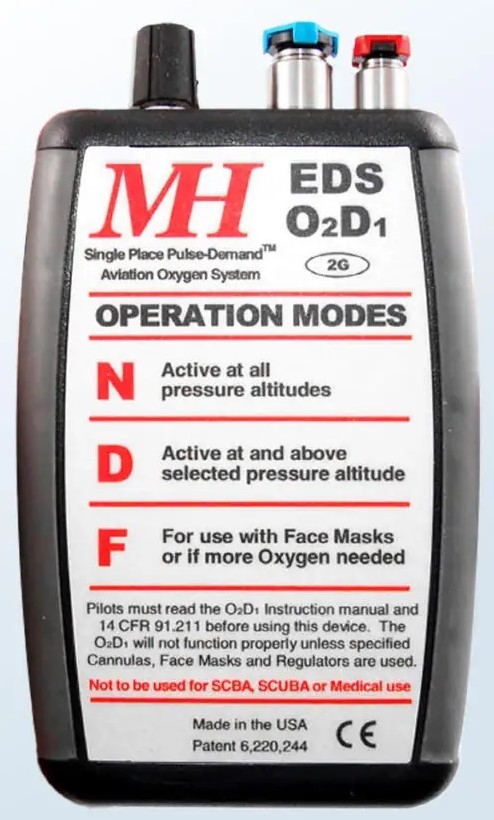
.jpg)
Application (human interface) device, Cannulas can be used for flight operations below 18,000 ft. Face masks can be used for flight operations at and above 18,000 ft. (FAA, FAR 23.1447)
With many of today's home built aircraft capable of transporting man to high altitudes in near record time and where the average age of the pilot base is well over 45 years old, a practical knowledge of physiological human principals and atmospheric physics are not only desirable, but necessary in order to sustain safe operating parameters. Therefore, the pilot should have a firm understanding of the relationships between oxygen, altitude and the body.
Man can live for weeks without food and for days without water, but only a few minutes without oxygen. Because man can not store oxygen in his body, as he can food and water, he lives a breath-to-breath existence. He continues to live and function only as long as he can continually replenish the oxygen consumed by his metabolic process.
Oxygen becomes more difficult for your body to obtain with altitude because the air becomes less dense, and the total (absolute) air pressure decreases compromising your primary (lungs) and secondary (bloodstream) respiratory system the ability to transport and exchange oxygen throughout the body, even though the percentage of oxygen (21%) remains constant with respect to the atmosphere.
As altitude is increased and the pressure of oxygen is reduced, the amount of oxygen transferred into the lungs is reduced which results in a decrease in the amount of oxygen available in the blood. It is when oxygen saturation in the blood begins to decrease that the chances of becoming hypoxic increase.
According to the Webster dictionary, hypoxia is defined as "a deficiency of oxygen reaching the tissues of the body". Some of the most common indications (symptoms) of hypoxia are:
- An increased breathing rate
- Lightheadedness or dizzy sensation
- Tingling or a warm sensation
- Cold chills and/or cold extremities
- Sweating and increased heart rate
- Reduced color vision and visual field
- Sleepiness, insomnia and/or nervousness
- Blue coloring of skin, fingernails and lips
- Behavior change, giddiness, belligerence, cockiness, anxiousness or euphoria
Hypoxia does not hit you all at once. It comes on slowly, at a speed that is mainly a function of your altitude and somewhat of your condition. The higher you go, the faster hypoxia will take effect. Experiencing any of the effects indicating the onset of hypoxia is just as, if not more, insidious as the condition itself. Simply put, once you have convinced yourself you are experiencing hypoxia, it's simply too late. You are now mentally and physically operating at a fraction of your capacity and losing more at a fast rate. Supplemental oxygen will prevent this dangerous phenomena.
Many pilots who have experienced hypoxia claim they never know at what altitude and what effect they will experience hypoxia when it strikes. In fact, some pilots go on to say that they can practice a breathing technique to reduce or control it. Unfortunately, in this case this practice simply yields little or nothing at all. You need to use supplemental oxygen.
Many high altitude chamber experiments have shown that a person affected by hypoxia may not recognize but a fraction of it's know indications. In fact, some experienced pilots don't even report experiencing any effects at all while they are obviously incapacitated. This is where the insidious nature of hypoxia is so dangerous. Without oxygen you are not going to reverse it anywhere as quick as you bought it on. But with oxygen you can speed up the reversal. The trick is to not get hypoxia in the first place. Many pilots black-out or faint in flight each year from hypoxia. Some now fly with oxygen. Most don't. Many of the so-called pilot error deaths and serious accidents, where to mechanical failure was found for cause, are in fact thought to have been caused by hypoxia.
While it is true that some pilots can tell that hypoxia has taken effect and pilot themselves to safety, premature landing without oxygen is neither reliable nor safe. At one altitude you may experience one effect and yet another at another time at the same or less altitude experience yet another incapacitating effect, thus not recognizing you have hypoxia. In addition, what works for one pilot may not work for another. It is much less a problem and far safer to keep ahead of and out of the hypoxia area than to catch up and get out of it. The best way to accomplish this is by using supplemental oxygen.
Mountain High offers a wide selection of systems and components for both carry-on and built-in oxygen needs.
Q & A
The air surrounding us is a mixture of gases consisting of 78% nitrogen and 21% oxygen. The remaining 1% is made up of argon, carbon dioxide, and traces of rare gases.
Under normal conditions, pure oxygen is a colorless, tasteless, odorless, non-combustible gas. It is the most important single element in our universe.
Although it will not burn alone, oxygen supports combustion; in fact, without oxygen there can be no fire. Oxygen, therefore, is not only necessary for the burning of combustible materials, but it is also absolutely essential to support the process of "vital combustion" which maintains human life. Although a person can live for weeks without food or for days without water, he or she dies in minutes if deprived of oxygen. The human body is essentially a converter which consumes fuel and produces heat and energy. It is like a furnace which utilizes the oxygen in the air to burn coal, thus producing heat and power. The human body must have oxygen to convert fuel (the carbohydrates, fats, and proteins in our diet) into heat, energy and life. The conversion of body fuels into life is similar to the process of combustion; fuel and oxygen are consumed, while heat and energy are generated. This process is known as "metabolism".
At each breath we fill our lungs with air containing 21% oxygen. Millions of tiny air sacs (know as "alveola" in our lungs inflate like tiny balloons. In the minutely thin walls enclosing each sac are microscopic capillaries, through which blood is constantly transporting oxygen from the lungs to every cell in the body. Because the body has no way to store oxygen, it leads to a breath-to-breath existence.
The rate of metabolism, which determines the need for and consumption of oxygen, depends on the degree of physical activity or mental stress of the individual. A person walking at a brisk pace will consume about four times as much oxygen as he or she would when sitting quietly. Under severe exertion or stress, he or she would be consuming eight time as much oxygen as when resting.
When the body is deprived of an adequate oxygen supply, even for a short period, various organs and processes in the body begin to suffer impairment from oxygen deficiency. This condition is known as "hypoxia". Hypoxia affects every cell in the body, but especially the brain and the body's nervous system. This makes hypoxia extremely insidious, difficult to recognize, and a serious hazard especially for flight personnel.
Hypoxia causes impairment of vision (especially at night), lassitude, drowsiness, fatigue, headache, euphoria (a false sense of exhilaration), and temporary psychological disturbance. These effects do not necessarily occur in the same sequence nor to the same extent in all individuals, but are typical in average persons who are affected by hypoxia.
Supplementary oxygen must be used to enrich the air we breathe to compensate for either a deficiency on the part of the individual or a deficiency in the atmosphere in which we are breathing. A person may have a respiratory or circulatory impairment which reduces the ability of the body to utilize the 21% oxygen in the air. For such a person supplementary oxygen must be administered by an oxygen tent or by an oxygen mask to enrich the inhaled air. The total volume of oxygen in each inhalation is then so much greater than normal that it compensates for the individual's own physical inability to utilize normal atmospheric oxygen. When we ascend in altitude a different condition is encountered: a condition in which the individual may be perfectly normal, but in which there is an oxygen deficiency in the atmosphere and supplementary oxygen must therefore be used.
No, the ratio of oxygen to nitrogen in the composition of the air does not change. The 21% of oxygen in the air remains relatively constant at altitudes up to one 100,000 feet.
The blanket of air which surrounds our planet is several hundred miles thick, compressible, and has weight. The air closest to the earth is supporting the weight of the air above it and, therefore is more dense; its molecules are packed closer together. As we ascend in altitude the air is less dense. For example, at 10,000 feet, the atmospheric pressure is only 2/3 of that at ground level. Consequently, the air is less dense, and each lungful of air contains only 2/3 as many molecules of oxygen as it did at ground level. At 18,000 feet the atmospheric pressure is only 1/2 of that at ground level. Although the percentage of oxygen is still the same as at ground level, the number of molecules of oxygen in each lungful is reduced by 1/2.
As we ascend, there is a progressive reduction in the amount of oxygen taken into the lungs with each breath, and a corresponding decrease in the amount of oxygen available for the bloodstream to pick up and transport to every cell in the body. To compensate for this progressive oxygen deficiency, we must add pure oxygen to the air we breathe in order to maintain enough oxygen molecules to supply the metabolic needs of the body.
In general, it can be assumed that the normal, healthy individual in unlikely to need supplementary oxygen at altitudes below 8,000 feet. One exception is night flying. Because the retina of the eye is affected by even extremely mild hypoxia, deterioration of night vision becomes significant above 5,000 feet. Between 8,000 and 12,000 feet, hypoxia may cause the first signs of fatigue, drowsiness, sluggishness, headache, and slower reaction time. At 15,000 feet, the hypoxic effect becomes increasingly apparent in terms of impaired efficiency, increased drowsiness, errors in judgment, and difficulty with simple tasks requiring mental alertness or muscular coordination. These symptoms become more intensified with progressively higher ascent or with prolonged exposure. At 20,000 feet, a pilot may scarcely be able to see (much less read) the instruments. His or her hearing, perception, judgment, comprehension, and general mental and physical faculties are practically useless. The pilot may be on the verge of complete collapse. Therefore, the availability and use of supplemental oxygen is recommended on nigh flights where altitudes above 5,000 feet are contemplated and for altitudes above 8,000 feet on daytime flights.
Without some measuring device such as a portable pulse oximeter, you can't. Therefore, oxygen should be used before it is needed. The most dangerous aspect of hypoxia is the insidious, "sneaky" nature of its onset. Because the effects of hypoxia are primarily on the brain and nervous system, there is a gradual loss of mental faculties, impairment of judgment, coordination, and skill; but these changes are so slow that they are completely unnoticed by the individual who is being affected. Actually, a person suffering from mild or moderate hypoxia is apt to feel a sense of exhilaration or security, and may be quite proud of his or her proficiency and performance although he or she may be on the verge of complete incompetence.
Because hypoxia acts upon the brain and nervous system, its effects are very much like those of alcohol or of other drugs which produce a false sense of well-being. There is a complete loss of ability for self-criticism or self-analysis. Some people believe that a pilot can detect his or her need for oxygen by noting an increase in breathing rate, an accelerated heartbeat, and a slight bluish discoloration (cyanosis) of the fingernails. However, by the time these symptoms develop, the individual is more likely to be mentally incapable of recognizing these signs. The person may even decide that he or she has always wanted blue fingernails! Even while “spiraling” out of control, the individual may be convinced (if conscious at all) that he or she is doing this deliberately and enjoying it immensely.
Refine Search
MH-00REG-2100-06
Regulator, Assy 2G, 2100 series CGA-540 (No Gauge w/Port)Regulator, CGA-540 (2G), Single-Stage..
$289.00
MH-00REG-2100-10
Regulator, Assy 2G, 2100 series CGA-540 (No Gauge w/Port)Regulator, CGA-540 (2G), Single-Stage..
$289.00
MH-00REG-2100-14
Regulator, Assy 2G, 2100 series CGA-540 (No Gauge w/Port)CGA-540 (2G) CPC Type outlet port (4 Port)C..
$499.00
MH-00REG-2101-04
1-Place Axial CGA-540 Gauged RegulatorRegulator, CGA-540 (2G), Single-Stage (Gauged)-CGA-540 (2G) Ga..
$349.00
MH-00REG-2101-10
Regulator, Assy 2G, 2101 series CGA-540 Gauged-Regulator, CGA-540 (2G), Single-Stage (Gauged) C..
$349.00
MH-00REG-2101-14
XCR-4P-G, Four Place CGA-540 Regulator with GaugeCGA-540 (2G) Gauged, CPC Type outlet port (4 Port)C..
$559.00
MH-00REG-2110-04
REG 2G, 1-place Axial Regulator, No GaugeDIN 477-9 Euro inlet, 4mm Push-to-Connect axial outlet, Non..
$305.00
MH-00XCP-0002-xx
One, Two or Four Place System with MH3 or MH4 Flowmeter(s), XCP or FPR Regulator, KF-011 (11 cu. ft...
$1,295.00
MH-00XCP-0004-xx
Two or Four Place System with MH3 or MH4 Flowmeter(s), FPR Regulator, KF-022 (22 cu. ft.) Kevla..
$2,340.00
MH-00XCP-0010-xx
Two or Four Place System with MH3 or MH4 Flowmeter(s), FPR Regulator, KF-077 (77 cu. ft.) Kevlar Wra..
$2,695.00
MH-00XCP-0014-xx
Two or Four Place System with MH3 or MH4 Flowmeter(s), FPR Regulator, CFFC-048 (48 cu. ft.) Carbon F..
$1,600.00
MH-00XCP-0052-xx
One Place System with MH3 or MH4 Flowmeter(s), XCP or FPR Regulator, AL-113 (4.1 cu. ft.) Alumi..
$559.00
MH-00XCP-0054-xx
One or Two Place System with MH3 or MH4 Flowmeter(s), XCP or FPR Regulator, AL-180 (5.8 cu. ft.) Alu..
$599.00
MH-00XCP-0058-xx
One, Two, or Four Place System with MH3 or MH4 Flowmeter(s), XCP or FPR Regulator, AL-248 (8.8 cu. f..
$625.00
MH-00XCP-0060-xx
One, Two, Four, or 6 Place System with MH3 or MH4 Flowmeter(s), XCP or FPR Regulator, AL-415 (14.7 c..
$659.00
MH-00XCP-0062-xx
One, Two, Four, or 6 Place System with MH3 or MH4 Flowmeter(s), XCP or FPR Regulator, AL-647 (22.8 c..
$749.00
MH-00XCP-0064-xx
One, Two, Four, or 6 Place System with MH3 or MH4 Flowmeter(s), XCP or FPR Regulator, AL-682 (24.1 c..
$689.00
MH-00XCP-0082-xx
One, Two, or Four Place System with MH3 or MH4 Flowmeter(s), XCP or FPR Regulator, CFF-480 (18.2 cu...
$1,299.00
MH-00XCP-1030-xx
XCP Tubing Extension (Variable Lengths)Extend the length of the tubing on your XCP system.CPC Male f..
$35.00
MH-00XCP-1036-00
MH3 Flowmeter with CPC Fittings for use with XCP systemsFor Oxymizer Cannula Only - 18,000 feetThe M..
$79.00
MH-00XCP-1037-00
MH4 Flowmeter with CPC Fittings for use with XCP systemsFor Oxymizer Cannula or Standard Cannula or ..
$79.00
MH-00XCP-1040-01
Aviators Standard CannulaCalibrated for use with the MH4 flowmeter or any other device calibrated to..
$6.00
MH-00XCP-1044-00
Oxymizer Cannula - XCP versionThe Oxymizer's unique oxygen-conserving reservoir design accumulates (..
$32.00
MH-00XCP-1046-00
XCP Pendant-Style Oxymizer Cannula for use with our MH-3 flowmeters.Also available with the more pop..
$32.00
MH-00XCP-1048-00
XCP-Style Split KitSplit Kit 6mm (Y) CPC style connectors. Allows (2) EDS units to be installed to o..
$55.00
MH-00XCP-1050-01
XCP Standard Face MaskConstant flow face mask to be used with a MH-4 flowmeter.This is the standard ..
$12.00
MH-00XCP-1070-00
Breathing Station with MH3 Flowmeter and Oxymizer Cannula - 18,000 feetFor use with XCP system. ..
$130.00
MH-00XCP-1071-00
Breathing Station with MH4 Flowmeter and Oxymizer Cannula - 18,000 feetFor use with XCP system. ..
$135.00
MH-00XCR-0002-x1
One Place System with MH3 or MH4 Flowmeter, XCR-1P-Axial Regulator, KF-011 (11.0 cu. ft.) Kevla..
$1,195.00
MH-00XCR-0050-x1-x
One Place System with MH3 or MH4 Flowmeter, XCR-1P-Axial Regulator, AL-113 (4.1 cu. ft.) Alumin..
$659.00
MH-00XCR-0054-x1-x
One Place System with MH3 or MH4 Flowmeter, XCR Regulator, AL-180 (5.8 cu. ft.) Aluminum Cylinder an..
$540.00
MH-00XCR-0058-x1
One Place System with MH3 or MH4 Flowmeter, XCR Regulator, AL-248 (8.8 cu. ft.) Aluminum Cylind..
$749.00
MH-00XCR-1032
Breathing Station with MH3 flowmeter, Control Holster, Oxymizer and Face MaskThis is the XCR type co..
$312.00
MH-00XCR-1034
Breathing Station with MH4 flowmeter, Control Holster, Oxymizer and Face MaskThis is the XCR type co..
$312.00
MH-00XCR-1036
XCR-F1 Standard Face MaskThis is the standard face mask that is included in XCR systems. Calib..
$14.90
MH-00XCR-1040
Oxymizer Cannula - XCR versionReplacement conserving cannula for XCR systems only.Use of this Cannul..
$50.00
MH-00XCR-1044-00
XCR-Style Split Kit for Expanding StationsSplit Kit 4mm (Y) . Allows (2) EDS units to be installed t..
$31.00
MH-00XCR-1046
XCR Delivery System with MH3 Flowmeter, XCR-1P-Axial regulator and Oxymizer CannulaThe XCR Delivery ..
$449.00
MH-00XCR-1048
XCR Delivery System with MH4 Flowmeter, XCR-1P-Axial regulator and Oxymizer CannulaThe XCR Delivery ..
$449.00
MH-00XCR-1052
XCR Delivery System with MH3 Flowmeter, XCR-DIN-G regulator and Oxymizer CannulaThe XCR Delivery Sys..
$499.00
MH-00XCR-1054
XCR Delivery System with MH4 Flowmeter, XCR-DIN-G regulator and Oxymizer CannulaThe XCR Delivery Sys..
$499.00
MH-09001-0011-90
O-RING 2-011 V90Replacement O-Ring for all CGA-540 Regulator & Trans-fill.Fits CGA-540 Nipple...
$1.00
MH-09001-3113-70
O-RING 2-113 E70 (DIN)Replacement O-Ring for all DIN-477#9 regulators & transfill.Fits DIN 477-9..
$1.00
MH-09005-0001-00
E-Clip Retaining ring for CGA Nipples.Retaining ring E 5/8Retains the nut from slipping on the Nippl..
$1.00
MH-09008-0080-00
Clamp, Oetiker, #8.0This 8.0mm Oetiker ear clamp is our most popular size.It is used here in the ass..
$1.60
MH-09008-0087-00
Clamp, Oetiker, #8.7This 8.7mm Oetiker ear clamp.Generally uses on 9/16 OD tubing.Features:-Made fro..
$1.75
MH-0MH34-0101-03
MH3 FlowmeterFor Oxymizer Cannula Only - 18,000 feetThe MH3 has an altitude/flow scale calibrated fo..
$73.80
MH-0MH34-0101-04
MH4 FlowmeterFor Oxymizer Cannula or Standard Cannula or Standard Face Mask - 25,000 feetThe MH4 flo..
$73.80
MH-19056-0403-00
Fitting one touch 4mm x 1/8 BSPP, 180º, one-touchOne-Touch 4mm x 1/8″ BSPP 180′ Fitting...
$16.00
MH-19056-0499-02
Cap, 4mm Red Collar4mm red indicator cap as used on the oxygen inlets on all O2D1 and all O2D2 units..
$1.00
MH-19056-0600-00
Union 6mm 180*, one-touchMountain High Coupler, 6 x 6 mm, for use connecting 2 blue 6 mm tubing..
$6.00
MH-19056-0604-00
Fitting 6mm x 1/8 BSPP 90º, one-touchMountain High Regulator output port, for using 6 mm blue tubing..
$6.00
MH-19056-0699-06
Cap, 6mm Blue Collar19056-0699-06, Small blue cap for low-pressure port on EDS-O2D1-2G and O2D2-2G..
$1.00
MH-36990-0USB-03
Cable, USB to DC Plug 3.5mmO2D2 external USB power cableUSB CableAircraft grade nylon braided cable ..
$24.95
MH-39300-1245-00
O2D2-EPS External Power Supply for O2D2-2G Systems This adapter allows you to power a 4.5VDC el..
$29.00
MH-60000-0012-00
Tote BagHandy 12″ X 12″ zippered fabric tote bag for storing cannulas, face masks, flowmeters or oth..
$7.50
MH-AMSK
Alps Face MaskThe newest members of the Mountain High family of products are the MH ALPS FaceMask an..
$189.00
MH-AMSK-010x-00
All Feedtubes for ALPS MasksChoose your connection EDS or Constant Flow.Connect your ALPS mask to ou..
$5.00
MH-CMK-Omega
CMK Ω ('Omega') Cylinder Mounting Kits The CMK ‘OMEGA’ type bracket cylinder mounting kit is a rigi..
$0.00

